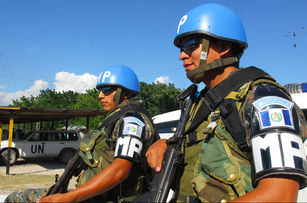I had no way of knowing that my beloved Haiti ushered in the second generation of disaster, demobilization and reintegration (DDR) processes worldwide prior to taking Professor Dean Piedmont’s course on this subject. I did however always wonder why MINUSTAH – the UN’s peacekeeping force – has been in Haiti for so long. Upon learning that DDR is in fact a peacebuilding process aimed primarily at reintegrating ex-combatants into civilian society post-war, the presence of MINUSTAH became even more perplexing to me since Haiti was never at war.
Furthermore, while the 2004-2006 period in Haiti’s history was marked by a critical upsurge in violence before and after a U.S. supported coup d’etat, there were also no clear ex-combatant groups to reintegrate back into Haitian society. Therefore, rather than looking to DDR to reinforce a newly independent country’s statehood as the first generation of DDR did after the Cold War, the failure of DDR in Haiti led to this second wave where DDR increasingly focused on the role of development in reducing livelihood concerns that often lead to violence (as an aside, today’s third generation of DDR emphasizes attempts to counter violent extremism [CVE] through political integration).
In addition to DDR, Haiti has also been one of the sites for a related process known as Security Sector Reform (SSR). SSR is more of a statebuilding measure designed to strengthen a country’s ability to create and uphold a climate of peace so that the country’s institutions can actually function. The Haitian National Police (HNP) was the main target for SSR initiatives and was actually making encouraging strides towards its goals in bolstering the civilian police force as recent as November 2009. Of course no one saw the January 2010 quake coming and almost all of the SSR gains being made were completely set back as a result. With the collapse of the national penitentiary, the Supreme Court, and almost every other major government building (the presidential palace included), renewed security concerns emerged in various ways.
Post-quake Haiti has not been wracked with no where near as much violence as that which initially warranted MINUSTAH eleven years ago (though the mission continues to maintain a reduced presence with its mandate having just been renewed at the end of October 2015 for another year). Even SSR, which was not as much of a failure as DDR, has not been a major topic of discussion for the Haitian state since it historically was viewed as an external process rather than one that had national ownership. At the same time, it goes without say that Haiti’s institutions remain underdeveloped and this reality will continually hinder long-term peace and security if it remains unaddressed.
With presidential elections currently underway and a new administration that starts in February 2016, the incoming Haitian president has a critical opportunity to establish a commitment to the country’s institutional building priorities that the Ministry of Planning and External Cooperation has outlined in its post-quake Strategic Plan for National Development. For one, this administration should diligently look to restore the citizenry’s faith in its state actors. The previous administration never executed the local and regional elections that were stalled by the earthquake and therefore ran his presidency by decree once the term of the parliamentarians expired. Since this will be the first time in a while that the state will have a functioning Parliament, actively working with the various branches of government – while also reinforcing the capacity of local and regional stakeholders – is one of many efforts that readily come to mind in terms of finally putting Haiti on a path towards sustainable development, peace and security.
Originally published as, “In Haiti, Statebuilding in the Wake of DDR and SSR.”



About The Author: Vanessa L.
More posts by Vanessa L.